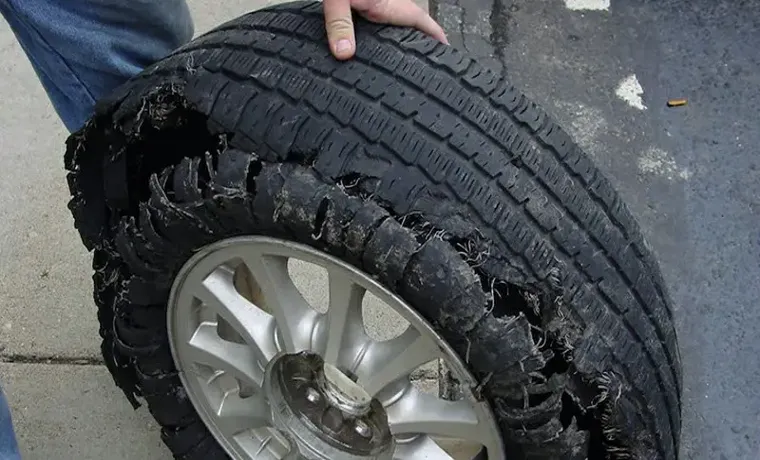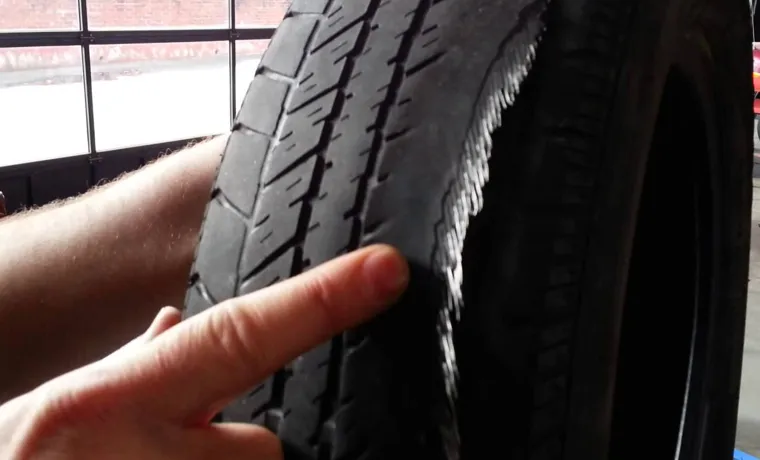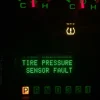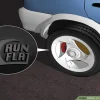Have you ever been on the road and felt a strange vibration or wobbling coming from your vehicle’s tires? It can be a nerve-wracking experience, especially if you are unsure of the cause. One of the potential reasons for this could be tire separation. Tire separation occurs when the layers of rubber and steel inside the tire start to come apart, and it can lead to dangerous situations if left unaddressed.
So, how exactly can you tell if a tire is separating before it’s too late? Firstly, you should be checking your tires regularly for any signs of wear and tear. Look for cracks or cuts in the sidewalls or any bulging or deformities in the tire itself. These are typical signs that a tire is failing and could be an indication of separation.
Additionally, if you notice any changes in the handling of your vehicle, such as increased steering difficulty or a change in the smoothness of the ride, it’s worth taking a closer look at your tires. Another way to check for tire separation is to inspect the tread. If you see any areas of the tread lifting away from the tire’s surface or shallow indentations on the tire’s surface, this can be a sign of separation and may require immediate attention.
It’s essential to remember that tire separation can happen suddenly, so being vigilant and proactive about checking your tires is crucial for your safety on the road. In summary, detecting tire separation early is crucial to ensure your safety on the road. Regularly checking your tires for signs of wear and tear, as well as changes in handling and tread, can help you identify any potential separation.
Remember, if you’re ever unsure about the condition of your tires, it’s always better to err on the side of caution and have them checked by a professional.
Table of Contents
Introduction
If you’re a car owner, knowing how to tell if a tire is separating is essential for your safety while driving. Tire separation happens when the rubber on the tire separates from the steel belts or the tire casing, leading to a bulge on the tread or sidewall. This can cause the tire to blow out while you’re driving, which can be serious and even deadly, especially if you’re traveling at high speeds.
One way to tell if your tire is separating is by checking for a bulge or bump on the tire’s surface or sidewall. Another sign of tire separation is a vibration in the steering wheel or the car’s body, especially when you’re driving at higher speeds. If you notice any of these signs, it’s crucial to have your tire checked by a professional as soon as possible.
Don’t take any risks when it comes to tire safety, as it can save your life and the lives of others on the road.
Explanation of tire separation
Tire separation is a serious issue that can occur when the layers of a tire separate from each other. This can cause the tire to bulge, leading to a potentially dangerous blowout while driving. The separation can be caused by a variety of factors, including manufacturing defects, overloading the vehicle, or overheating the tire.
It is important to regularly inspect your tires for signs of wear and tear, such as cracks in the sidewalls or bulges, and take preventative measures to avoid tire separation. If you suspect that your tire has separated, it is crucial to stop driving immediately and have the tire inspected by a professional. This can prevent accidents and ensure your safety on the road.
Remember to always prioritize your safety when it comes to tire maintenance.

Symptoms of a Separating Tire
If you’re wondering how to tell if a tire is separating, there are a few warning signs to look out for. One of the most obvious is visible bulges or bumps on the tire’s surface, which can indicate that the inner layers of the tire are starting to come apart. You may also notice that the tire seems to wobble or vibrate while you’re driving, especially at higher speeds.
This can be an indication that the tire’s structural integrity has been compromised and it’s no longer able to maintain a stable shape. Another symptom of tire separation is a noticeable decrease in handling and overall vehicle performance. If you notice any of these warning signs, it’s important to have your tires inspected by a professional as soon as possible.
Ignoring the problem could lead to a blowout or other serious safety issues on the road. Remember, regular tire maintenance is key to ensuring the safety and longevity of your vehicle.
Uneven wear on tread
Uneven wear on tire tread can be a sign that your tire is separating. This separation can manifest in a variety of symptoms, including vibrations, pulling to one side, and difficulty controlling the vehicle. While it can be difficult to identify a separating tire just by looking at it, your mechanic should be able to diagnose the problem with a thorough inspection.
If you notice any of these symptoms, it’s important to take your car in for servicing right away. Continuing to drive on a separating tire can be dangerous and can ultimately lead to a blowout on the road. Don’t take any chances when it comes to your safety- always take your car in for maintenance at the first sign of trouble.
Visible bulges or bubbles on the sidewall
If you see visible bulges or bubbles on the sidewall of your tire, it could be a sign of a separating tire. This occurs when the layers within the tire start to come apart, leading to a weakened structure that can result in dangerous blowouts. It’s important to address this issue immediately, as driving on a separating tire can be extremely risky.
You may also notice uneven wear on your tires, vibrations or shaking while driving, or a repetitive thumping sound originating from your tires. In any case, it’s crucial to get your tires checked by a professional as soon as possible. Remember, maintaining the health of your tires is essential for ensuring your safety on the road.
So, be vigilant and take action if you suspect your tires may be separating.
Vibration in steering wheel or vehicle
If you’re experiencing a constant vibration in your steering wheel or vehicle, it could be a sign of a separating tire. A separating tire is when the steel belts inside the tire begin to separate from the rubber, causing it to become unbalanced and vibrate. This is usually caused by hitting a pothole or curb, driving with low tire pressure, or just general wear and tear.
Other symptoms of a separating tire include a visible bulge or knot on the tire, a wobbling sensation while driving, and a feeling of losing control of the vehicle. It’s important to have a separating tire replaced as soon as possible, as it can lead to dangerous situations if left unaddressed. Always pay attention to changes in your vehicle and take it to a trusted mechanic if you suspect something is wrong.
Causes of Tire Separation
If you want to know if your tire is separating, you should first understand what causes tire separation. Tire separation is when the tread and other parts of the tire separate from each other, leading to a dangerous situation on the road. One of the main causes of tire separation is age.
As tires get old, the rubber begins to break down and separate from the cords that hold it together. Another cause is over-inflation or under-inflation, which puts too much pressure on certain parts of the tire and can cause them to separate. Additionally, hitting potholes, curbs, or other obstacles can damage the tire and cause separation over time.
It’s important to regularly inspect your tires and replace them if they show signs of wear or damage to avoid the risk of separation while driving. By keeping an eye on your tires and having them serviced by a professional, you can keep yourself and your passengers safe on the road.
Overinflation or underinflation of tire
Tire Separation is a serious safety issue that can occur while driving due to overinflation or underinflation of tires. Overinflation can cause excessive wear and tear on the center of the tire, leading to belt separation and eventual tire failure. On the other hand, underinflation can cause too much flexing of the tire’s sidewalls, generating excessive heat, and increasing the risk of a blowout.
Other causes of tire separation include tire manufacturing defects, hitting potholes, and driving on rough roads. It’s crucial to keep an eye on your tire pressure and ensure it’s at the manufacturer’s recommended level. A tire pressure gauge is a handy tool to keep in your car to check the pressure of your car’s tires regularly.
By doing so, you can prevent tire separation and keep yourself and your passengers safe on the road.
Excessive load on tire
One of the most prevalent causes of tire separation is excessive load on the tire. When a tire is subjected to more weight than it is designed to handle, the internal components of the tire can deteriorate, leading to separation. This is particularly common in commercial vehicles, where heavy loads are a regular occurrence.
Additionally, overinflating a tire to support a heavy load can also lead to separation. It’s important to follow the manufacturer’s guidelines for tire weight limits and inflation levels to prevent tire separation. Always check the load rating on your tires and make sure not to exceed it.
By doing so, you’ll keep your tires in optimal condition, ensuring both your safety and that of others on the road. Remember, your tires are the only connection between your vehicle and the road, and it’s essential to keep them in top-notch condition for a smooth and safe ride.
Old or worn-out tires
One of the most common causes of tire separation is old or worn-out tires. Over time, the rubber in tires can degrade, which can weaken the tire’s structure and make it more prone to separation. When the tire separates, its components can break apart, which can cause the tire to lose air and ultimately lead to a blowout.
This can be especially dangerous when driving at high speeds or under adverse weather conditions. To prevent tire separation, it’s important to have your tires inspected regularly and replaced when they show signs of wear and tear. Additionally, always make sure the tires you purchase are the right size for your vehicle and are rated for the type of driving you do.
By taking these steps, you can help ensure that your tires will perform safely and reliably for years to come.
What to Do If You Suspect Tire Separation
If you suspect your tire may be separating, it is important to take immediate action to avoid a potentially dangerous situation. A tire separation occurs when the tire tread separates from the tire, resulting in a loss of control while driving. One way to tell if your tire is separating is to look for visual signs, such as bulges or cracks along the sidewall or tread.
Additionally, you may notice a vibration or loud noise while driving, which could also indicate a tire separation. If you suspect this is the case, pull over to a safe location as soon as possible to inspect your tires and call for assistance if necessary. It is crucial to never continue driving on a tire that may be separating, as this can lead to a serious accident.
Regular tire maintenance and inspections can also help prevent tire separations from occurring in the first place.
Slow down and be cautious
If you suspect tire separation while driving, it’s important to take immediate action to prevent any accidents or further damage to your car. The first step is to slow down and be cautious – don’t panic or make any sudden movements. Try to maintain a steady speed and keep your vehicle as stable as possible.
Then, try to find a safe place to pull over and inspect your tires. Look for signs of separation, such as bulges, cracks, or tears in the rubber. If you notice any damage, don’t attempt to drive on the tire – call a professional for assistance.
Remember, your safety comes first. Don’t ignore any warning signs or risks, and don’t hesitate to seek help if you have any doubts. With these tips in mind, you can stay safe on the road and prevent tire separation from causing any harm to you or your vehicle.
Get the tire inspected by a professional
If you suspect tire separation, the first thing you should do is to get the tire inspected by a professional. Tire separation is a serious issue that can cause accidents, so it’s important to address it as soon as possible. A tire that has separated can lose air pressure and cause the vehicle to shake or vibrate, making it difficult to control.
If you notice any signs of tire separation, such as bulges, cracks, or uneven wear, have the tire inspected by a qualified technician. They will be able to determine the extent of the damage and advise you on the best course of action. Remember, prevention is always better than cure, so never ignore any signs of tire separation and take appropriate action to ensure your safety on the road.
Consider replacing the tire
If you suspect tire separation, one of the most important things you can do is to take immediate action. This problem can be potentially dangerous, especially if it happens while you’re driving at high speeds. It’s essential to pay attention to the warning signs, such as vibrations or unusual noises, and check the tire’s tread for signs of wear and tear.
If you notice any damage, consider replacing the tire as soon as possible. Don’t try to repair a damaged tire yourself, as this can be incredibly risky and may make the situation worse. Instead, take it to a professional who can inspect and repair or replace the tire as needed.
By being vigilant and proactive, you can keep yourself, your passengers, and other drivers on the road safe from potential accidents. Remember, safety always comes first!
Conclusion
In conclusion, much like a relationship, a tire separation involves a painful separation between the layers and eventually a disastrous breakdown. To prevent such a calamity on the road, lookout for visible bulges, unusual vibrations, or an abnormal tire tread pattern. Remember, a healthy tire is the foundation for a smooth ride, just like a healthy relationship is a cornerstone for a happy life.
Take care of your tires, so they can take care of you!”
FAQs
1. What are the signs that indicate tire separation? A: The signs include steering wheel vibration, unstable driving, uneven tire wear, and unusual noise from the tire. 2. How common is tire separation? A: Tire separation is a rare occurrence and happens in less than 1% of cases. 3. Can tire separation lead to an accident? A: Yes, tire separation can lead to a serious accident as it can cause sudden loss of vehicle control, resulting in a collision. 4. How often should you check for tire separation? A: It is recommended to check for tire separation every 10,000 miles or during routine maintenance. 5. Can tire separation be repaired? A: No, tire separation cannot be repaired. The only solution is to replace the tire. 6. How long do tires usually last before separation occurs? A: Tires can last up to 6 years before separation occurs, but it depends on various factors such as tire quality, driving habits, and road conditions. 7. What should you do if you suspect tire separation? A: If you suspect tire separation, pull over to a safe location and inspect the tire for any visible signs of damage. If you see any signs of separation, replace the tire immediately.



